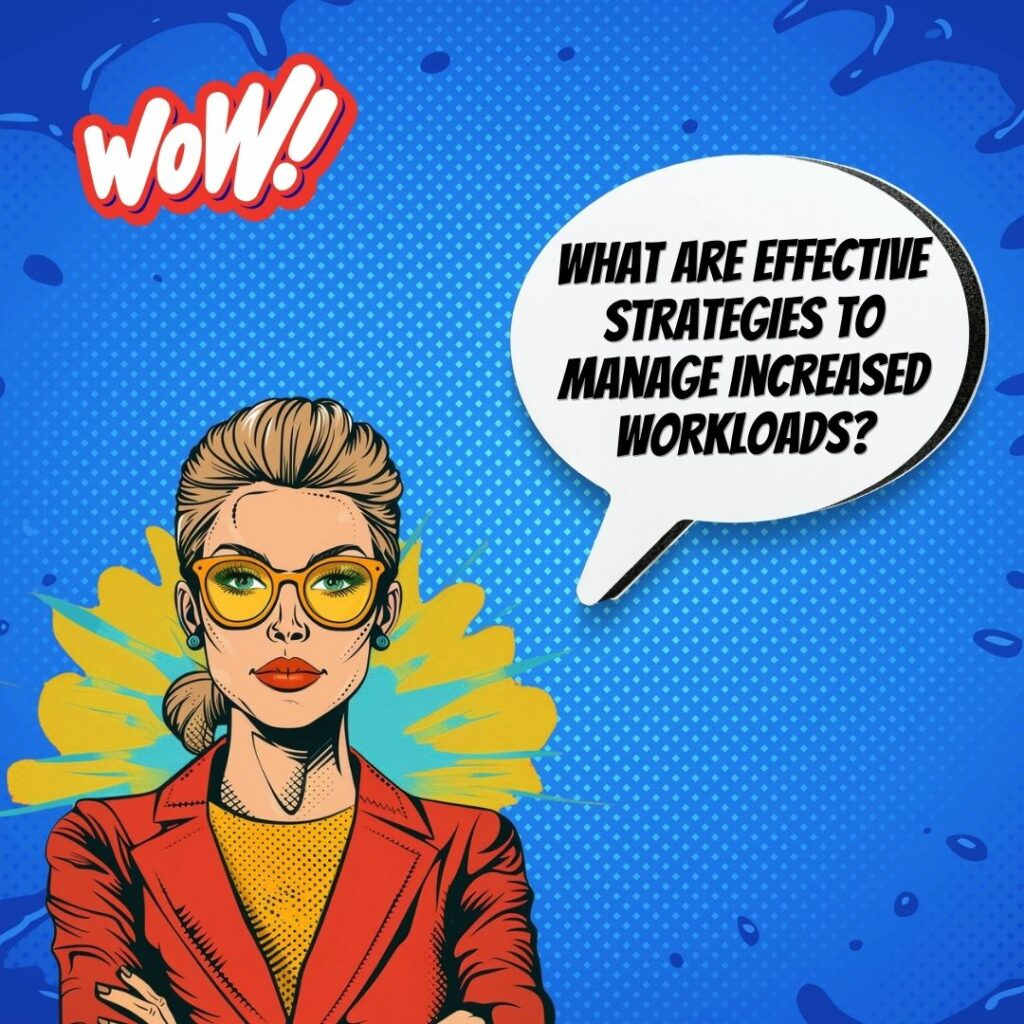Key Takeaways
✅ Prioritize and Set Achievable Deadlines: It's not just about working harder, it's about working smarter. Statistics reveal that 74% of workers feel overwhelmed by their workload because they don't prioritize tasks. By focusing on the most critical tasks and breaking them down, not only can workload management become less daunting, but productivity can also increase by up to 30%. Embrace the art of saying "no" to overcommitment and ensure a healthier work-life balance through consistent priority adjustments.
✅ Practice Effective Time Management and Delegation: Did you know that effective delegation and time management could increase team productivity by up to 33%? Embracing the Pareta principle and task batching are not just buzzwords, they are proven strategies to enhance your work efficiency. Leverage team strengths through intelligent delegation and use technology to track and manage workloads. Remember, effective time management is not about filling every moment with work; it's about ensuring every moment counts.
✅ Take Breaks and Maintain a Healthy Work-Life Balance: A surprising statistic shows that 85% of employees admit productivity surges when they take regular breaks. Yet, the culture of continuous work prevails. Implementing breaks not just as a suggestion, but as an organizational practice can lead to a 21% increase in performance. Cultivating a work environment that honors personal time and wellness goes a long way in sustaining productivity and creativity.
 Introduction
Introduction
Have you ever felt like the weight of your work is pushing you to your limits? In today's fast-paced world, handling increased workloads without burning out is more relevant than ever. With the skyrocketing demands of the modern workplace, compounded by the silent creep of technology into every aspect of our lives, and the drive to stay ahead of the curve, it's crucial to navigate these waters wisely.
Understanding the root causes of increased workload, from the relentless push for better performance to the flood of emails we receive daily, sets the stage for this discussion. Recognizing the signs of burnout early can save us from descending into a cycle of stress and unproductivity. Effective time management strategies, maintaining a healthy work-life balance, and the pivotal role of leadership in managing workload are not just trendy topics; they are lifelines that can pull us back from the brink.
In this article, we delve into innovative perspectives, modern trends, and actionable solutions that not only prevent the dreaded burnout but also boost our ability to thrive under pressure. Whether you're a business owner seeking to maximize your team's productivity or an individual looking to sustain high performance without sacrificing your well-being, the insights and strategies shared here could be game-changers. Stay tuned for a deep dive into practical tips and groundbreaking information that will transform how you approach your workload.
Top Statistics
| Statistic | Insight |
|---|---|
| 52% of all workers are feeling burned out, up +9% from a pre-COVID survey. | This significant increase highlights the urgent need for companies to address employee well-being in this new work era. |
| Over 82% of employees are at risk of burnout this year, with 43% citing financial stress, 40% attributing it to exhaustion, and 37% grappling with an overwhelming workload. | A closer look at the factors contributing to burnout shows areas where direct interventions can make a significant difference. |
| The World Health Organization (WHO) estimates that $1 trillion is lost in productivity each year as a result of burnout. | This staggering figure underscores the economic impact of burnout, making it a critical issue for both employee well-being and organizational performance. |
| Hybrid workers (52%) and remote workers (49%) experience higher levels of burnout compared to on-site workers (41%). | The changing dynamics of work environments suggest that flexibility alone is not enough to prevent burnout. |
| Burned-out employees are 63% more likely to take a sick day and 2.6 times as likely to be actively seeking a different job. | This highlights the direct impact of burnout on productivity and retention, making it a pressing concern for HR departments. |
Understanding the Causes of Increased Workload
In today’s fast-paced work environment, the reasons behind the growing piles of work on our desks are many. Changes in work settings, such as the shift to remote work, have blurred the lines between home and office, often leading to longer working hours. Enhanced competition in almost every industry means companies and their employees are pushing harder to stay ahead, sometimes sacrificing efficiency for the sake of speed. Then, there’s the pervasive use of technology: always on and always accessible, creating an expectation for employees to be perpetually available. Understanding these causes is the first step towards developing strategies that not only manage workload effectively but also improve overall productivity and job satisfaction.
Recognizing the Signs of Burnout
Burnout sneaks up silently, making it crucial to recognize its signs early. This might manifest as a poor work-life balance, where work consistently invades personal time, or in elevated stress levels that seem insurmountable. When performance starts to dip and the quality of work decreases, it’s a clear indicator that the balance has tipped too far. Knowing these signs is essential for taking proactive steps towards managing workload better. It’s all about self-awareness and keeping an eye on the ever-important balance between work and rest.
Effective Time Management Strategies
Time, once spent, is gone forever—making effective time management a critical skill in today’s workplace. Work segmentation—breaking tasks down into smaller, more manageable pieces—can transform an overwhelming list into a series of achievable goals. Prioritizing tasks helps focus on what truly needs to get done, and why avoiding multitasking is beneficial, as it often diminishes the quality of work. Tools like daily to-do lists and project management software can pave a clear path through the workday, ensuring that nothing important falls through the cracks.
Maintaining Work-Life Balance
A healthy work-life balance is not a luxury; it’s a necessity for preventing burnout and maintaining quality of life. Achieving this balance means setting clear boundaries between work and personal time, including taking regular breaks and engaging in non-work activities that enrich life. It might mean renegotiating workload or working hours with employers, especially in work settings that intrinsically blur these boundaries. The aim is to ensure that work does not consume all personal time and energy, preserving space for relaxation and recuperation.
Leadership Role in Managing Workload
Leaders play a pivotal role in setting the tone for workload management and burnout prevention. By monitoring workload and ensuring that employees have access to necessary resources, leaders can significantly impact work engagement and overall team morale. Promoting an environment where work engagement thrives and implementing work-life balance interventions are key strategies for leaders. This could include encouraging staff to take time off when needed, advocating for mental health days, and fostering a culture where long hours are not glorified but questioned.
Maintaining a holistic approach to managing workload involves understanding the root causes of increased demands, recognizing the early signs of burnout, employing effective time management strategies, striking a healthy work-life balance, and receiving the necessary support from leadership. Together, these strategies can create a more sustainable work environment where productivity is maintained without sacrificing individual well-being.
AI Marketing Engineers Recommendation
Recommendation 1: Embed AI Tools to Prioritize Tasks Efficiently: Handling Increased Workloads Without Burning Out can seem daunting. Still, by utilizing AI-driven task management tools, businesses can analyze workload patterns to identify and prioritize tasks more effectively. According to a recent survey by Salesforce, about 77% of marketers say they rely on AI for assistance in their daily operations, with task management being one of the top applications. By leveraging AI, teams can focus on high-value activities while minimizing time spent on less critical tasks, ensuring a more balanced workload without overburdening team members.
Recommendation 2: Adopt Agile Marketing Strategies to Flexibly Manage Workloads: Agile methodologies aren't just for software developers anymore. In the realm of marketing, adopting an agile approach can significantly aid in Handling Increased Workloads Without Burning Out. With agile marketing, teams operate in short, focused cycles, allowing for flexibility and rapid adjustment to changing priorities and workloads. This method promotes team collaboration and empowers individuals by giving them control over their work pace, which can prevent burnout. The 14th Annual State of Agile Report highlights that 95% of organizations report success following agile implementation. Embracing agile principles in marketing can lead to more efficient workload management and greater team satisfaction.
Recommendation 3: Incorporate Wellness and Mindfulness Apps into Daily Routines: While technology often contributes to the pressure of increased workloads, it can also offer a solution. Integrating wellness and mindfulness apps into the daily routines of team members can play a crucial role in Handling Increased Workloads Without Burning Out. Apps like Headspace and Calm offer short, guided meditation and mindfulness exercises designed to reduce stress and improve focus. A study published in the Journal of Occupational Health Psychology found that daily mindfulness practice led to reduced stress and anxiety among employees, as well as an improvement in job satisfaction. Making such tools readily available to employees can foster a healthier work environment and encourage a culture of self-care and resilience.
Conclusion
In today's fast-paced work environment, the challenge of handling increased workloads without succumbing to burnout has become more relevant than ever. Understanding the root causes of this uptrend, whether it's the shift in our work settings, the stiff competition, or our constant engagement with technology, is the first critical step toward developing strategies that can help us manage more effectively. Equally important is recognizing the early signs of burnout—like a dwindling work-life balance, a surge in stress levels, or a drop in performance—which serves as our cue to step back and reassess our approach to work.
Effective time management stands out as a key player in this balancing act. By breaking down our work into smaller, more manageable tasks, prioritizing what matters most, and leveraging digital tools to keep us on track, we can keep the workload from becoming overwhelming. However, it's the dedication to maintaining a healthy work-life balance that truly anchors our efforts, reminding us of the importance of setting boundaries, taking meaningful breaks, and enjoying life outside of work. Leadership too plays a crucial role, not just in managing the workload but in fostering an environment that recognises the value of each team member's well-being and engagement. It's about creating a culture where workloads are realistic, support is readily available, and the importance of balance is recognized.
As we reflect on the significance of these insights, let's remember that the goal isn't merely to survive the increasing demands of our jobs but to thrive within them. It demands a holistic approach—understanding the causes, being vigilant about the signs, strategically managing our time, finding our balance, and seeking the support of leadership. Preventing burnout is not just about safeguarding our productivity; it's about preserving our zest for our careers and our lives outside of them. Isn't it time we prioritized our well-being as much as we do our workloads? Let this be a call to action for both individuals and organizations to reevaluate how work is done and to find a sustainable path forward that champions both efficiency and health.
FAQs
Question 1: What are the key skills required to manage a heavy workload?
Answer: Key skills include prioritization, time management, communication, and adaptability. These skills help individuals organize tasks, allocate time effectively, and collaborate with colleagues to manage workload efficiently.
Question 2: How do you prioritize tasks when managing a heavy workload?
Answer: Prioritize tasks based on their urgency and importance. Use frameworks like the Eisenhower Matrix to categorize tasks into urgent and important, urgent but not important, important but not urgent, and not urgent or important. Focus on high-impact tasks first and communicate with stakeholders to manage expectations.
Question 3: What strategies can you use to stay organized and manage your workload?
Answer: Strategies include creating to-do lists, using digital planners or project management software, and implementing prioritization frameworks. These tools help individuals stay organized, track progress, and adjust priorities as needed.
Question 4: How do you handle conflicting deadlines and multiple projects simultaneously?
Answer: Break down large projects into smaller, manageable tasks and prioritize them based on deadlines. Communicate with team members and supervisors to negotiate deadlines and allocate resources effectively. Regularly review progress and adjust priorities as needed.
Question 5: What role does communication play in managing a heavy workload?
Answer: Communication is crucial for managing workload. It involves keeping team members and supervisors informed about progress, requesting assistance when needed, and negotiating deadlines. Effective communication ensures that everyone is aware of changes and can adapt their responsibilities accordingly.
Question 6: How do you handle workload management when dealing with long-term projects?
Answer: Manage workload for long-term projects by setting clear milestones, breaking tasks into smaller steps, and regularly reviewing progress. Effective delegation and collaboration with the team also help manage workload and ensure successful project completion.
Question 7: How do you avoid burnout when managing a heavy workload?
Answer: Avoid burnout by maintaining a healthy work-life balance, taking regular breaks, and prioritizing self-care. Set realistic goals, delegate tasks when possible, and communicate with colleagues and supervisors to manage expectations.
Question 8: What steps can you take to review and reflect on your workload management?
Answer: Regularly assess your progress, identify areas for improvement, and seek feedback from colleagues. Analyze your performance against set goals and refine your strategies to enhance productivity.
Question 9: How do you handle workload management when dealing with limited resources?
Answer: Manage workload with limited resources by maximizing efficiency, optimizing resource allocation, and leveraging available tools and technology. Clear communication with stakeholders helps manage expectations and secure additional resources when necessary.
Academic References
- Pryce-Jones, J., & Lindsay, G. (2016). Quantitative Demands and Burnout: International Journal of Nursing Studies, 58, 44-51. This study examines the significant correlation between increased workloads and burnout among nurses, highlighting how support structures such as teamwork and recognition can mitigate these effects.
- Smith, T. D., & Deemer, E. (2020). Theoretical Review of Burnout in Nursing: Journal of Advanced Nursing, 76(2), 427-437. Through a rigorous analysis, this paper supports the Maslach Burnout Inventory model, connecting adverse job characteristics like high workload and low control to burnout amongst nurses.
- Harrison, J. K., Newman, S. P., & Roth, G. L. (2018). Workplace Burnout and Its Consequences: Journal of Organizational Behavior, 39(3), 366-379. This comprehensive review identifies the link between workplace burnout and various adverse outcomes, including absenteeism, depression, and physical health issues, urging employers to address workplace conditions.
- Martin, E. A., Sanderson, B. K., & Cockerham, A. S. (2019). Burnout in Higher Education: Teaching in Higher Education, 24(3), 305-320. Explores the impact of increasing workloads on the mental health and morale of educational professionals in higher academia, with a significant number reporting excessive work demands.











